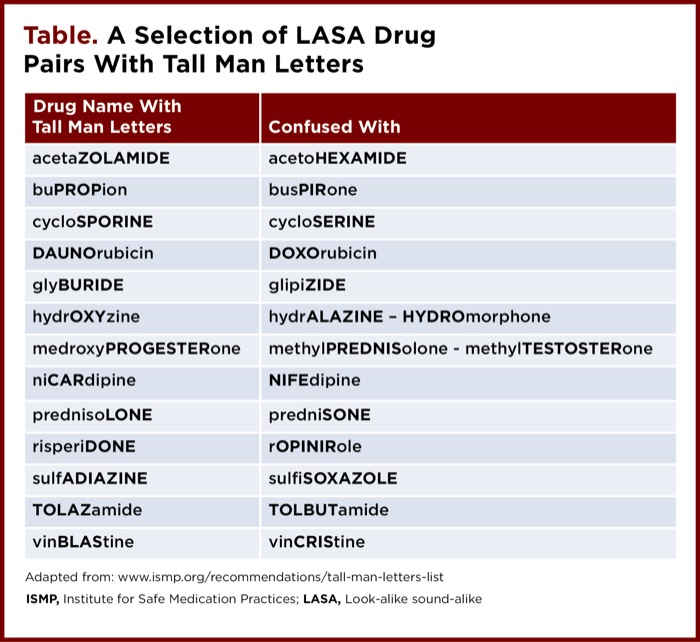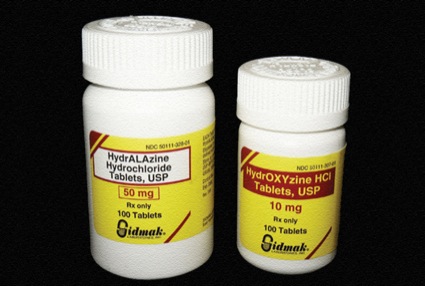
The Clinical Problem
Look-alike, sound-alike (LASA) medication names can lead to the unintended interchange of drugs and result in adverse events, serious patient harm, and significant health care costs.1 The potential for accidental drug mix-ups is high, given the thousands of medications currently marketed and new ones being added continuously. It has been estimated that 1 out of every 1,000 prescriptions involves a wrong-drug error, and drug name confusion is thought to be a key cause.2,3 This issue may be particularly problematic when 2 drugs with similarly sounding names, for example, Keppra and Keflex, are available in the same strengths and can be dosed with the same route and frequency.
How to Manage the Problem
Strategies to prevent LASA drug errors include the use of tall man (mixed case) lettering for LASA drug names (Table), storage of LASA drugs in different locations, configuring computer selection screens (“picklists”) to prevent LASA drug names from appearing consecutively, inclusion of brand and generic names on orders and labels, adding extra security labels to the outer packaging of LASA drugs, and the use of barcode technology.4
| Table. A Selection of LASA Drug Pairs With Tall Man Letters | |
| Drug Name With Tall Man Letters | Confused With |
|---|---|
| acetaZOLAMIDE | acetoHEXAMIDE |
| buPROPion | busPIRone |
| cycloSPORINE | cycloSERINE |
| DAUNOrubicin | DOXOrubicin |
| glyBURIDE | glipiZIDE |
| hydrOXYzine | hydrALAZINE – HYDROmorphone |
| medroxyPROGESTERone | methylPREDNISolone - methylTESTOSTERone |
| niCARdipine | NIFEdipine |
| prednisoLONE | predniSONE |
| risperiDONE | rOPINIRole |
| sulfADIAZINE | sulfiSOXAZOLE |
| TOLAZamide | TOLBUTamide |
| vinBLAStine | vinCRIStine |
| Adapted from: www.ismp.org/recommendations/tall-man-letters-list ISMP, Institute for Safe Medication Practices; LASA, Look-alike sound-alike | |
Health care organizations also monitor LASA drug errors within their institutions and stay abreast of new LASA drugs by regularly reviewing lists of confused drug names, such as the one maintained by the Institute for Safe Medication Practices (ISMP).5 The FDA and patient safety organizations, such as the ISMP and the Joint Commission, also have recommended including the purpose of a drug with each prescription to help distinguish between LASA drugs. However, this approach has not been as widely adopted as the other strategies listed above.
New Insights: How Drug Indications Can Help
Including an indication with each prescription has become more feasible with the expanding use of electronic health records and the availability of information on drug indications that can be accessed in electronic prescribing systems. There is mounting evidence that adding indications to prescription drug orders is beneficial for reducing medication errors and improving medication use. Two recently published studies specifically relate to the utility of using indications to differentiate between LASA drugs.6-7 In one study, researchers used indications from a proprietary knowledgebase that contained both FDA-approved and unapproved off-label indications for prescription and nonprescription drugs on the ISMP LASA list.6 Practicing clinicians independently reviewed and validated each drug/indication association. After comparing the indications for each pair of LASA drugs, the researchers found that associating even a general indication (eg, “bacterial infection” for Keflex and “seizure disorder” for Keppra) could help differentiate between 80% of the nearly 280 LASA drug pairs evaluated.
This finding was consistent with that from an earlier study comparing indications extracted from the prescribing information for 33 look-alike drug name pairs identified by the FDA.7
Why Including Indications on Drug Prescriptions Makes Sense
Adding a drug’s indication potentially can improve communication between and within health care teams; identify and prevent medication errors; and streamline processes for medication reconciliation, reimbursement, and prior authorization.8 Indication information also can facilitate review of prescribing patterns and drug utilization within a health system. In addition to distinguishing between LASA drug pairs, incorporating indications into the prescribing workflow may help prevent wrong-patient errors, reduce the number of calls from pharmacists to prescribers to clarify orders, facilitate deprescribing of medications, and increase patient medication knowledge and satisfaction.9-14
Although the optimal workflow has yet to be established and indeed may vary among different practice sites and settings, the reasons for including indications with each prescription are compelling enough that we will likely see more research and discussions on optimal ways to achieve this goal. In 2016, Schiff et al advocated for the incorporation of indications into the medication ordering process and recognition of the right indication as a “sixth right” of safe medication use—to join the other “rights”—correct patient, drug, dose, time, and route.8 Regulatory agencies and patient safety organizations have long recommended including a purpose or “reason for use” for each drug order. The time may be ripe for this to finally happen.
References
- Hoffman JM, Proulx SM. Medication errors caused by confusion of drug names. Drug Saf. 2003;26(7):445-472.
- Cina JL, Gandhi TK, Churchill W, et al. How many hospital pharmacy medication dispensing errors go undetected? Jt Comm J Qual Patient Saf. 2006;32(2):73-80.
- Flynn EA, Barker KN, Carnahan BJ. National observational study of prescription dispensing accuracy and safety in 50 pharmacies. J Am Pharm Assoc. 2003;43(2):191-200.
- WHO Collaborating Centre for Patient Safety Solutions. Look-alike, sound-alike medication names. Patient safety solutions. 2007;1. www.who.int/ patientsafety/ solutions/ patientsafety/ PS-Solution1.pdf. Accessed September 2, 2018.
- Institute for Safe Medication Practices, List of confused drug names. Updated February 2015. www.ismp.org/ recommendations/ confused-drug-names-list. Accessed September 2, 2018.
- Cheng CM, Salazar A, Amato MG, et al. Using drug knowledgebase information to distinguish between look-alike-sound-alike drugs. J Am Med Inform Assoc. 2018;25(7):872-884.
- Seoane-Vazquez E, Rodriguez-Monguio R, Alqahtani S, et al. Exploring the potential for using drug indications to prevent look-alike and sound-alike drug errors. Expert Opin Drug Saf. 2017;16(10):1103-1109.
- Schiff GD, Seoane-Vazquez E, Wright A. Incorporating indications into medication ordering – time to enter the age of reason. N Engl J Med. 2016;375(4):306-309.
- Warholak TL, Rupp MT, Leal S, et al. Assessing the effect of providing a pharmacist with patient diagnosis on electronic prescription orders: a pilot study. Res Social Adm Pharm. 2014;10(1):246-251.
- Linsky A, Meterko M, Stolzmann K, et al. Supporting medication discontinuation: provider preferences for interventions to facilitate deprescribing. BMC Health Serv Res. 2017;17(1):447.
- Galanter W, Falck S, Burns M, et al. Indication-based prescribing prevents wrong-patient medication errors in computerized provider order entry (CPOE). J Am Med Inform Assoc. 2013;20(3):477-481.
- Galanter WL, Bryson ML, Falck S, et al. Indication alerts intercept drug name confusion errors during computerized entry of medication orders. PLoS ONE. 2014;9:e101977.
- Burnside NL, Bardo JA, Bretz CJ, et al. Effects of including medication indications on prescription labels. J Am Pharm Assoc. 2007;47(6):756-758.
- Kron BS, Myers S, Volk L, et al. Incorporating medication indications into the prescribing process. Am J Health Syst Pharm. 2018;75(11):774-783.


